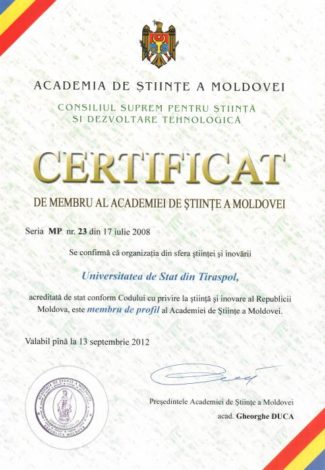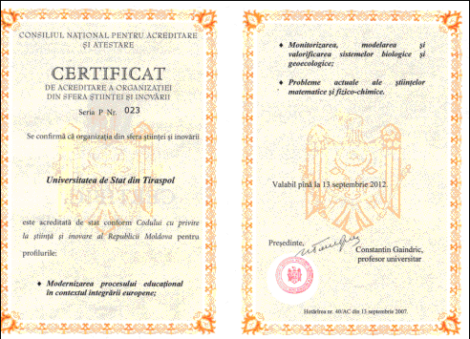Activity of scientific research and innovation
Recorded in the education system of the Republic of Moldova as the first institution of higher education, Tiraspol State University, along with the activity of teacher training, also develops a wide investigative activity. Much attention has been paid to the research and innovation activity since the foundation of the institution. The oldest higher education institution of the country has a team of scientific-teaching staff with extensive research experience, who subsequently formed the basis of the scientific staffs from various higher education and research institutions in the republic. Highly qualified scholars were working as early as the interwar period: Cozac M.I., Lingau N.G., Şcerbac I.D., Porodico F.M., Iaroşenco M.F. (academician), Volcov I.F., Agasieva N.A. and so on.
The first scientific staff bodies were created in the academic year 1937-1938. Then laboratories of Physics, Chemistry, Botany, Physical Geography and Geology were opened, which contributed to the establishment of the technical-material basis for the process of study and scientific research. Besides this, the scientific library with a solid book fund and a zoo museum was founded.
By 1940 a competent scientific staff body was formed which contributed to the formation of the Pedagogical Institute in Chișinău. The years of World War II negatively marked the country’s education and scientific research system, inclusively the institute’s one. The economic disaster, the drought, the famine, the deportations, and the repression have markedly reduced the number of scientific-didactic and scientific staff of the Institute. In the post-war period, the completion of laboratories and chairs with highly qualified staff began. In 1954, only Șapiro M.A., Macarov F.P., Crăciun P.I., Mareţchi S.C., Cotenco I.A., Cozlovschi M.I., Crăciun T.A., Volcov I.F. were involved in the scientific research activity.
A radical change that contributed to the revitalization of the scientific research sector was the merging and reorganization in 1954 of some faculties of teacher-education and pedagogical institutes in Chişinău, Bălţi, Tiraspol and Cahul. The next academic year as a result of this restructuring there were working 20 PhDs (candidates) in science that constituted a competent scientific potential, able to restore and reinvigorate the scientific activity in the laboratories of Chemistry, Geography, Physics, Biology, etc in Tiraspol State University.
In April 1955, for the first time in the post-war period, the conference of totalizing the results of the scientific activity of the Institute staff took place. Within it, 30 reports were presented in 4 sections: Social Sciences, Physical Sciences, Biological Sciences and Geographical Sciences. Subsequently, organizing annual conferences has become a tradition. In the same year the teaching staff published a Russian-Moldovan dictionary of mathematical terms, intended for students, school teachers, teachers from educational institutes and schools.
In 1956, in connection with the 25th anniversary of TSU foundation, the first volume of works “Ученые записки ТГПИ” was published. These volumes continued to be edited until the early 1970s. Also, in the 70s the first bibliographic collections of the staff’s scientific works appear: the first volume includes more than 1500 titles, while the second one – more than 2000 titles.
An important event was the appearance of the four books in the history of Mathematics in school, author G. Gleizer. Other publications valuable for the corresponding fields belong to the collaborators A. Novac [1], I. Cotenco, V. Zapadaev, P. Petric, C. Sluţcaia [2], and N. Mihai [3]. Many collaborators of the institute (V. Titov, V. Sobeţchi, B. Crivţun, E. Feldman, V. Crupinschi, N. Mihai, I. Antoseac, G. Verşigora, A. Fedorov, I. Cotenco, A. Novac) were authors and co-authors of the textbooks for the pupils of secondary school or students of higher education institutions: “Elements of Cartography”, “Historical Geology”, “Chrestomathy in literature for class VII”, “Arithmetic for class VI”, “Basics of Plant Cultivation” and others. In addition, supports are published for the theoretical and practical courses, and for the independent work of the students. There were particularly noticeable V. Titov, E. Ţurcan, E. Natanzon, G. Bogatîreva et al.
The revived tradition at the end of the 1950s to organize scientific conferences to totalize the results of the scientific researches of the teachers and students is maintained throughout the history of the UST. Since the 1960s, at least 1-2 conferences have been held annually in the fields of Biology, Geography, Mathematics, Physics, Chemistry, Pedagogy and Philosophy.
Since the 70’s within TSU at the State Command, scientific research works of great importance are carried out in various fields as Crystallography and Semiconductor Physics, Chemistry, Physiology, Geography, Paleogeography, Geology, Pedagogy, and Social Sciences. The editorial activity is also prodigious. There are published new books, scientific articles, collections of articles and theses, materials of the scientific conferences that reflect the research results obtained by TSU staff.
The contemporary stage of development of scientific research in the University is related to the name of Miroslav Cozlovschi – well-known scientist and mentor of a plethora of physicists, scientists and school teachers who for the first time studied the influence of the electric field on the crystallization processes in solutions and, also for the first time, determined experimentally the quadratic dependence of the crystallization speed on the intensity and polarity of the electric field. This dependence was established experimentally and demonstrated theoretically. Also, an increase in hardness and modification of the physical properties of the thin films was determined. In 1973 M. Cozlovschi was awarded the title Emeritus of Higher Education from the MSSR. He was decorated with the order “Badge of Honour”.
The 1980s were quite fruitful for researchers of the Institute. There was carried out research at the State Command, each Department was included in a research topic, scientific events were organized, numerous scientific publications appeared where the results obtained by the researchers of the Institute were shared. During this period, there started the training of teaching and research staff in many scientific centers and higher education institutions in Moscow, Leningrad, Kiev, Tbilisi, Cernigov, Novosibirsk and others began.
At the beginning of the 1990s, when the Institute obtained the new status of the University and was forced to take refuge in Chișinău, was a rather difficult period, but even then the members of the research staff did not stop their activity. United in departments they continued to conduct research in the priority areas for the country. These years, as well as the beginning of the 2000s were an endeavour for TSU, because during this period it has been formed the new scientific basis which subsequently began to develop, being supported by the institutional projects and the university extra-budgetary funds.
Until 2014, at TSU, investigations were carried out in accordance with the priority directions of research and development: the exploitation of human, natural and informational resources for sustainable development, and nanotechnologies, industrial engineering, new products and materials. The investigation addresses the fundamental problem in the field of Exact Sciences (Mathematics, Physics and Computer Science) and natural sciences (Biology, Geography and Chemistry). The socio-pedagogical and psychological concepts and strategies of educational development in the Republic of Moldova, which constitutes another important research direction within TSU, are in full accordance with the contemporary trends of integration in the European Educational System. In 2007, TSU successfully passed the state accreditation procedure according to the Code on Science and Innovation of the Republic of Moldova for the profiles:
- Modernization of the educational process in the context of European integration;
- Monitoring, modelling and capitalization of biological and geo-ecological systems;
- Current problems of mathematical, physical and chemical sciences.
In 2008, TSU became a member of the Academy of Sciences of Moldova based on the results of the accreditation of the activity in the field of science and innovation. Later on, in 2012, the University is re-accredited in the field of scientific research and the following research profiles are confirmed:
- Concepts and strategies for modernizing the educational process;
- Regional study on geographic and biologic systems;
- Current problems of mathematical, physical and chemical sciences.
After re-accreditation, TSU reconfirmed its status as a member of the Academy of Sciences of Moldova.
[1] Novac A. Pervaia russcaia burjuazno-democraticescaia revoliuţia i revoliuţionnoe dvijenie v Rumânii (anii 1905-1907). 1966.
[2] Cotenco I., Zapadaev V., Petric P., Sluţcaia C. „Ocerchi istorii Tiraspolea”, 1967.
[3] Mihai N. Dialecticeschii materialism I sovremennaia fizica, 1968.


